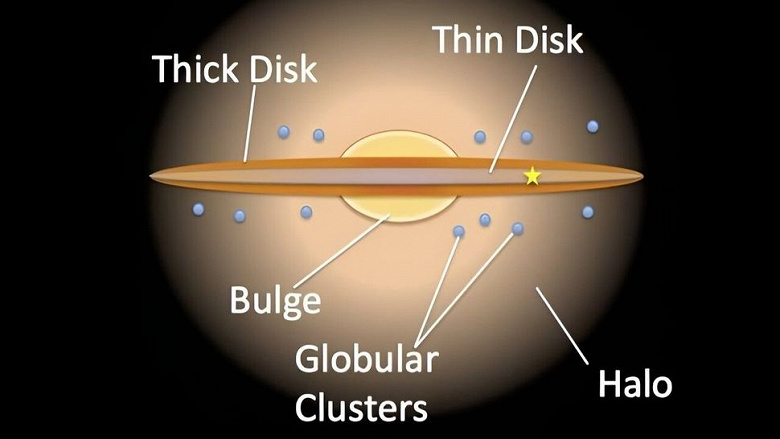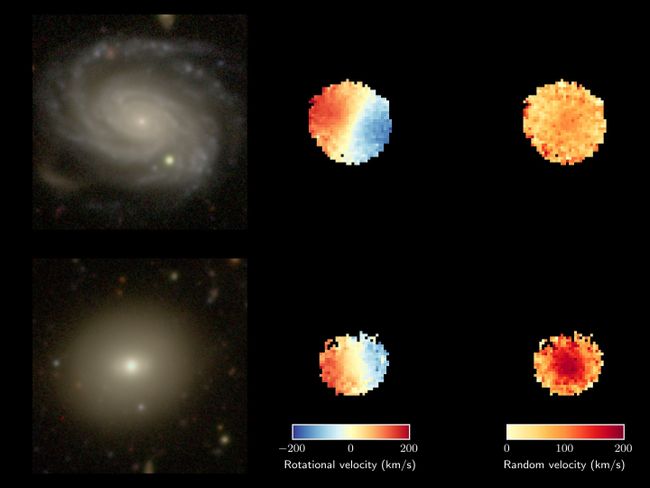In a study of 3000 galaxies, the Milky Way turned out to be special
Our sun — one of the billions of stars orbiting the center of the Milky Way galaxy. It orbits the galactic center every 225 million years, moving at a speed of about 828,000 km/h — astronomers call this the «galactic year». This orbit, although almost circular, twists slightly, rising and falling relative to the plane of the galaxy.
However, in other galaxies, the orbits of stars exhibit a much greater degree of randomness, with a variety of speeds and angles relative to the galactic plane. In elliptical galaxies, this behavior is explained by the result of a galaxy merger, which resulted in the formation of an elliptical galaxy and the orbits of the stars changed. But this is observed even in disk galaxies. This puzzles astronomers because stars in a disk galaxy form in a narrow, gas-rich plane called the thin disk. The Milky Way has a thin disk containing our Sun and most of the stars visible to the naked eye in the night sky.
The motion of stars in a thin disk usually follows a more or less circular path due to collisions between the gas clouds from which they arise. This creates an apparent rotation of the galaxy, and the smoothing of extreme motions leads to a decrease in the spread of orbital velocities between the fastest and slowest star — «velocity dispersion». Low velocity dispersion is common to most stars in circular orbits, while high velocity dispersion results in more random orbits.
Previous studies have indicated that a galaxy's mass and its surroundings can influence how stars move. However, a new study conducted by Australian astronomers offers a new perspective: it turns out that it is not mass and environment, but age that plays a decisive role in the nature of the motion of stars.
«Age» What describes a galaxy is not how long it has existed. It is believed that all galaxies formed around the same era, about 13 billion years ago. In this case, this is a condition for the star-forming activity of the galaxy. A galaxy in which new stars are still being born is considered to be «younger», and a galaxy in which star formation has stopped — «old».
«We found that age is the most important parameter. Once age is taken into account, the galaxy's environment and mass become less significant. Stars in “young” galaxy will have an orderly movement, regardless of the environment, while in the “old” there will be more random orbits in a galaxy, whether it is in a dense cluster or in empty space», — noted Scott Croome of the University of Sydney, who led the study.
However, that «age» and the environment, as well as the mass of the galaxy, are interconnected. For example, galaxies in denser environments have a greater chance of colliding and merging with other galaxies, which contributes to their rapid mass gain.

«We also know that the environment affects a galaxy's star formation activity. Once in a dense environment, the galaxy tends to stop star formation, — adds team member Jesse van de Sande, also from the University of Sydney.
There are two key mechanisms that can stop the process of star formation in galaxies. One of them — These are hot gas streams plunging into galaxy clusters that can squeeze gas from inside the galaxy, depriving it of material to form new stars. The second mechanism is associated with gravitational interactions between neighboring galaxies, which can mix gas inside the galaxy and cause rapid star formation. However, radiation from hot young stars, or from the jets of a supermassive black hole active due to the large amount of matter directed towards it, can heat the gas in the galaxy and prevent it from forming stars.
A team led by Krum and van de Sande came to the conclusion that the chaotic movements of stars «old» galaxies may be due to a combination of age effects. One of these effects is the birth of hot stars that are too energetic to move in circular orbits during the early stages of a galaxy's life. This process suppresses further star formation, preventing the galaxy from forming a thin disk with more ordered orbits.
It is noteworthy that the Milky Way was among those galaxies that successfully emerged from this process. The age of the thin disk of our galaxy is estimated at about 8.8 billion years. The thin disk, reaching a depth of about 350 light years, is embedded in a “thick disk” consisting of older stars. These older stars, with more erratic motions, formed a thick disk 1000 light-years deep, and their orbits have steeper angles relative to the galactic plane.
These findings are based on observations from the Krum and van de Sande team's survey of 3,000 galaxies using the SAMI galaxy spectrograph at Siding Spring Observatory in Australia.

